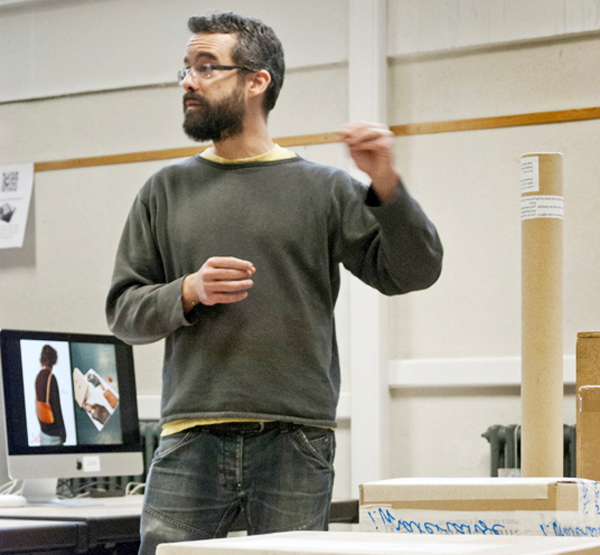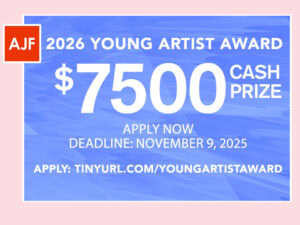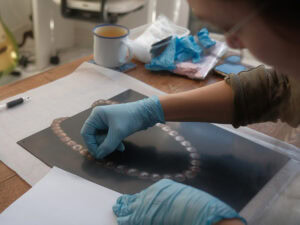We believe that it was a particular level of interest in contemporary jewelry that prompted you to become a member of AJF. We assume you spend a sizable amount of your time looking at other platforms, reading books and reviews we have not read, seeing exhibitions we will not see—basically shaping an independent point of view on what contemporary jewelry might be.
The interview by members was launched because we value your perspective. We want to provide a conduit so you can ask questions you think are relevant.
Our first (in-house) guest is new AJF editor Benjamin Lignel.
1. You mentioned you are a furniture maker. What is it about studio jewelry that appeals to you? After all, the AJF’s focus is toward art jewelry? Who are some of your favorite jewelry makers? Ivan Barnett, Santa Fe, New Mexico, USA
Benjamin Lignel: Actually, I trained as a furniture designer, not as a maker. In 1995 I completed an MA at the Royal College of Art in London and made my first ring during the degree show. Whenever there was a lull in visitor attendance, I would nip off to the jewelry department to cast silver in sycamore molds.
What initially appealed to me about jewelry was the shorter idea-to-finished-product time span. While designing a table could take as many as 18 months from start to finish, it would normally take a few weeks for a piece of jewelry. This is thanks in part to the fact that I did not fabricate the pieces myself. Rather, I outsourced them to a gentleman–a goldsmith–who I have been working with for the past 15 years.
My design training made it natural for me to outsource manufacture. Designers seldom make things themselves. This was met with some hostility at the beginning of my jewelry career, which in turn shaped my own position vis-à-vis the handmade, the unique, and the authorial gesture. I tend to like work that questions our assumptions about what constitutes contemporary jewelry. For example, I like Manon van Kouswijk’s ongoing research on how archetypal forms intersect with the language of the handmade. I like Suska Mackert’s manipulation of her ever-expanding photographic documentation on jewelry. I am excited by Gabriel Craig’s happenings and Roseanne Bartley’s participatory projects. Every one of these makers is very preoccupied by craft but shows a healthy disrespect for its given rules.
2. What projects and shows you have coming up? Is there is a relationship between your work, your writing, and your other projects? What’s an example of how this works? Sienna Patti, Lenox, Massachusetts
My activities are roughly divided in three areas: making work, curating shows or organizing events, and writing about contemporary craft. I just opened a duo show with Kiko Gianocca in Paris, which capped an intensive three months of work. Before that, I worked on the forthcoming book Contemporary Jewelry in Perspective edited by former AJF editor Damian Skinner, which involved a lot of collective discussions. I have also started to work on the Circuit du Bijou, a project that will kick off in September in Paris. It will involve a number of institutional and commercial shows, a two-day seminar, and some performances. The French association la garantie, for which I am secretary, is organizing the seminars, and I will curate a show addressing the notion of difference and repetition in jewelry.
While I try to keep these activities somewhat separate–to avoid going insane, probably–they undoubtedly inform one another. When I started working on Contemporary Jewelry in Perspective, I already had an interest, as a maker, in how players in the field—the makers, their commercial representatives, the institutions, and the press—create value. Working on the first part of the book with Damian Skinner, Namita Wiggers, Monica Gaspar, and Kevin Murray gave me a far better grasp on the sociological aspect of this field and market, which in turn spilled into my recent exhibition. Meanwhile, a text I wrote on van Kouswijk will serve as conceptual framework for the upcoming Difference and Repetition show. Basically, I think and try things out, and those two activities function like echo chambers for one another.
3. When AJF announced you would be the new editor, several people were worried that you would know very little about the American jewelry scene because you are French and most of your connections and knowledge are centered in Europe. Is this true? Susan Cummins, Tiburon, California
This is true. I know far more about European jewelry history than I do about American jewelry history. This means that when I edit Gabriel Craig’s review of Paul Mergen’s exhibition at the Arts Council of Greater Kalamazoo, I cannot assume that the critique of preciousness happened in the same way in Europe and in the US with the same effects. (I assumed it had and was corrected by Craig.)
I think this would be a problem if AJF positioned itself as a platform dedicated to contemporary jewelry history, and if I provided all of its content on my own, but there is a wide net of contributors writing for us (from seven continents, hailing from a variety of backgrounds). I think that AJF’s primary mandate is to report on and critically assess what the field is doing today. This means making sure we commission historians, but also involve makers, theorists, collectors, and curators to develop a multifaceted perspective.
I also think that appointing a European editor reflects the board’s ambition to cement AJF’s position as a global reporter in a field that is less and less defined by regional provenance and more and more by elective affiliation and affinities. AJF started as a group of globetrotting collectors dedicated to hunting far and wide for the best contemporary jewelry. Their cosmopolitan outlook informed their choice of a New Zealander as the first editor. I think that subsequently picking a Frenchman is daring but not incoherent.
4. How do you define the art jewelry that you have now committed yourself to? What are your main aims within this field, and do you see green pastures outside as well? Marjan Unger, Bussum, The Netherlands
I don’t believe there is one “art jewelry.” One of the issues plaguing this field is that we continue to treat it as one fragile thing that needs our anxious care and support. Meanwhile, the beauty of jewelry resides in large part in the insoluble conflicts and complexities within it. Lisa Gralnick’s practice—her creative intentions and how she implements them—takes a very different route from, say, Lola Brooks’s, and yet we assume they have enough in common to deserve the same handling (critical or otherwise). I don’t think this is true. Gralnick and Brooks do, however, have in common a certain reckless resolve to establish a conceptual and formal vocabulary that is unequivocally theirs. They both have a very clear notion of what the medium of jewelry can do for them, regardless of what the field of jewelry says about its own boundaries.
My commitment is to this constantly evolving hot potato of a creative practice. I have no doubt that it will be transformed beyond recognition in the next 20 years, and I intend to critically report on those transformations. One of these—which is not really news but is of some concern—is the fact that galleries that first put contemporary jewelry on the map, such as Galerie Louise Smit and Electrum Gallery, are shutting down and an aging population of collectors is not being replaced. The former is less worrying to me than the latter. A number of new galleries have opened in the past 10 years (Ornamentum Gallery, Caroline van Hoek) and in places not usually associated with contemporary jewelry (Ubi Gallery in Beijing, Atta Gallery in Bangkok). To these, one must add the growing trend of artist-run projects (Op Voorraad, B-Side, Dialogue Collective, Material Topics, to name just a few) and the extremely active online presence of younger makers. And institutional support isn’t really lacking. Statistically, jewelry graduates have a much better chance of showing in museums and public spaces than, say, students coming out of fine art departments.
A recent article by Liesbeth den Besten has stirred a behind-the-screen debate on best practices between galleries and artists. The absence of standardized rules regarding their mutual obligations means that both parties enjoy a certain freedom to “try things out.” (This could include direct sales, auction sales, Internet sales, Tupperware sales, or pop-up formats.) Clearer obligations, which some people advocate, would probably stem individual enterprise. But for now, our market shows the boisterous unruliness of a child in a toyshop.
So, the “green pastures” I have my eyes trained on are very much within the field, not outside of it. How will the community metabolize a worrying uniformity of style across the globe? Will it manage to outlive (once again) its oft-predicted death? We have two articles in the works on exactly these subjects.
5. What do you think is the best way to promote more interest in art jewelry, particularly in the United States? Mari Shaw, Philadelphia, Pennsylvania/Berlin, Germany
I used to bemoan makers’ nonchalant relationship to self-promotion and advocate better communication. By and large, I find that makers today are doing a rather fine job of advertising their work. The challenge is in giving this communication a currency outside the specialized audience that produces it. Getting an exhibition review by Roberta Smith is not going to put contemporary jewelry in the public domain. It will give it a legitimacy that we crave but do not need. Getting a review in Vogue might. I think that general interest media and women’s and fashion magazines are too readily dismissed as potential relays.
In addition, my own experience tells me that exhibiting with artists from other disciplines has the simple and obvious advantage of exposing your work to visitors who may have come to see your co-exhibitors. This audience will certainly look at your work if it is good enough.
But, these are simplistic answers to a question that usually deserves a case-by-case treatment. In France, for example, the issue of contemporary jewelry’s invisibility is historically tied to the staggering success of French luxury jewelry on one hand and to the lack of cultural support for individual enterprise on the other. England does not have these problems, nor does the US. Each country, therefore, deals with the problem in its own specific way. By regularly reporting on contemporary jewelry, AJF intends to contribute to this worldwide effort one article at a time.

When I took the editor’s position six weeks ago, I found that it relied on a loose network of approximately 65 writers. Mostly makers and historians have written for us, with some curators and collectors thrown in the mix. Given the size of the organization, this amounts to a considerable (if virtual) newsroom. However, once you consider how global our field is, the pool is relatively small. There are maybe six people I can commission in Australia to write a story, but only one in China, for example.
So, part of the editor’s task is to constantly be looking for people with an ability to look at objects precisely, write about them cogently, and who have enough time to do both. A 1500-word review usually requires some prior research, an exhibition visit, possibly an email exchange with the artist being exhibited, then the actual writing of the piece, followed by an occasionally intense back and forth editing process between the writer and the editor. In addition, writers also need to supply us with photographs and captions. This takes a serious amount of time and is compensated by a relatively small fee. Not everyone is prepared to make that sort of commitment. Be that as it may, my invitations to write have usually been accepted thus far, which I think reflects the pro-active spirit prevalent in our community.
I do find that people may be unaware of their writing abilities. Ours is a very hands-on field, and this instills a certain wariness or insecurity amongst makers regarding the written word. One of my goals is to carry on the very conscious “investment” in younger writers begun by previous editor Damian Skinner. I wish to encourage those with potential, make sure they are given reasons and opportunities to write, and accompany them through the editing process that follows.




